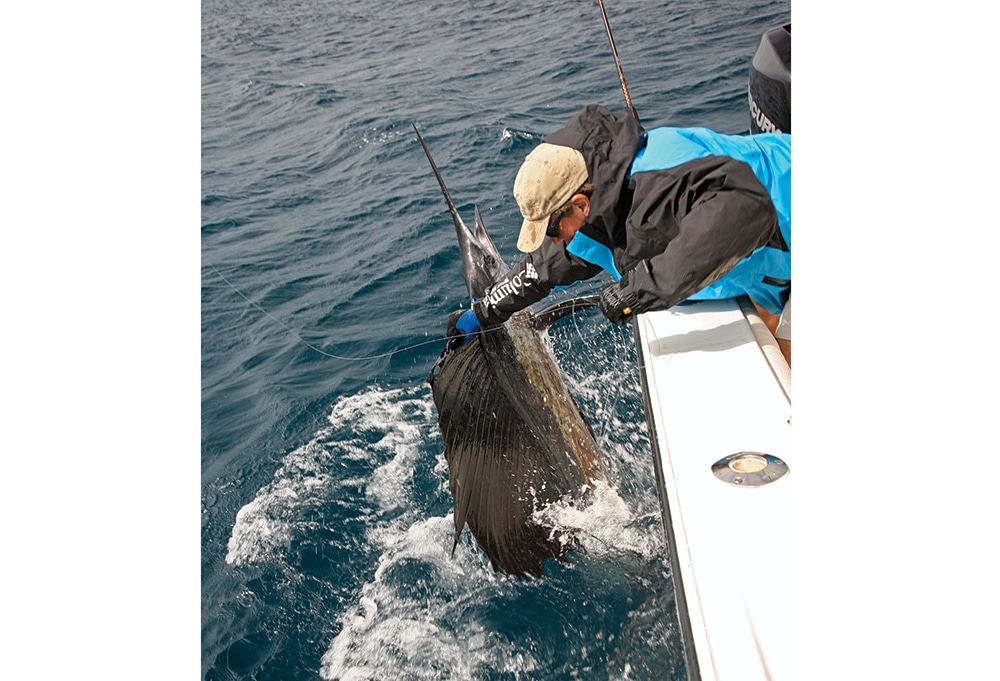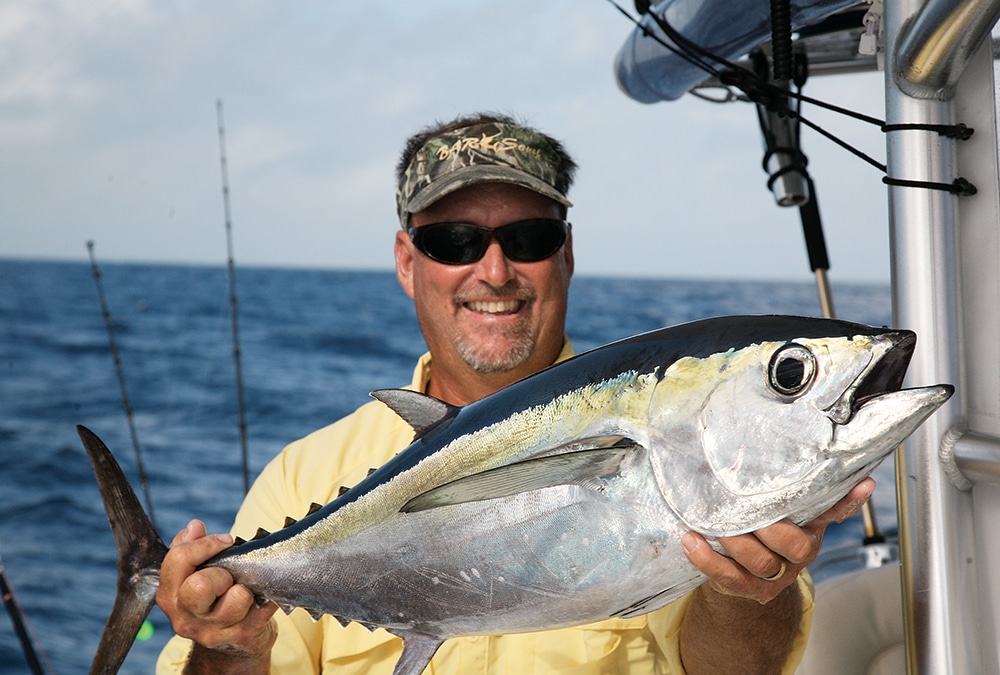
[Be sure to click through all the images in the gallery above.]
Capt. Jim Mulcahy and I were kite-fishing for sailfish off Key Largo with three frisky goggle-eyes dangling at the surface, and a pair of subsurface baits on flat lines. Water clarity and current were ideal, and flyingfish appeared abundant. Had we a stiff breeze and riled up seas, conditions would have been textbook perfect, but a 5-knot southeasterly breeze had the ocean as flat as a pancake.
Yet the kite prevailed, garnishing us two sailfish and several dolphin, while the flat-line baits went unnoticed, save for a single dolphin. Even better, we saw each fish rise to the kite baits from afar, through the still, transparent ocean.
Lift and Spread
Fishing kites present baits splashing at the surface, emitting distress vibrations that travel through the water column and over a broad swath of water. For example, when at drift, three to six baits can be fished downwind from one or more kites, whereas three to four additional baits can be fished upwind on flat lines, staggered at various depths.
But what about when there’s no breeze to fly them? Are they worthless? If you know how to keep them flying on a still day, kites can be every bit as effective, and sometimes even more so, as when there’s a moderate breeze.
Classical Gas
Flying a kite on windless days requires a helium tank — available through party-supply stores — and specially designed kite balloons, available through offshore-tackle retailers. A helium balloon affixed to a kite provides the lift to keep it up and maintain a spread of live baits dangling beneath it.
On our Bob Lewis fishing kite, we use floss to tightly cradle the balloon on the back, and then tape to precisely center it. For SFE and Frenzy kites, and with some modifications to the Bob Lewis kite, a device called the Kite Thong simplifies the attachment. The Kite Thong consists of three lengths of Dacron fastened to a heavier triangle of waxed cord. Two legs are secured to the top corners of the kite, whereas the third attaches to one of the bottom corners. The device secures the balloon to the kite, and allows fine-tuning for attitude, to help steer two kites away from one another.
Trickle-Down Theory
Even a helium-assisted kite needs finessing to keep it airborne and catching fish in an ultralight breeze. For light-wind duty, my kite reel is spooled with 50-pound braid, versus 80-pound braid on the ones used in medium and heavy winds. The lighter braid creates less drag and requires less effort to stay airborne on calm days.
A typical live-bait rig for sailfish is an in-line circle hook on 15 feet of fluorocarbon or nylon mono leader, with a small loop to attach to the snap swivel on the fishing line. Right above that snap swivel, and on the actual fishing line, is an egg sinker and a kite-marker float (for visual reference), in that order. With smaller baits — such as pilchards, herring and juvenile goggle-eyes — a weight is added to the fishing line, like 2 ounces; this provides enough ballast to lower that kite bait in a moderate breeze.
On windless days, a typical three-bait spread taxes the kite and pulls it down, especially when winding tight to a fish. To counter this, deploy smaller baits, and eliminate the weight on fishing lines. Consider eliminating a bait too — perhaps even two in extreme conditions — for more kite lift. However, if you’re adamant about a full spread of kite baits, try slow-trolling rather than drifting. This allows you to bump up your speed and raise the kite if the wind falls completely out, or when coming tight to a fish.
Precisely adjusting the kite-release clip tension is a balance between enough firmness to hold a frisky goggle-eye in place, yet loose enough to release when you come tight to a fish; the lighter the wind, the more crucial this adjustment becomes. Again, slow- or bump-trolling is good for creating bursts of wind when critically needed.
Dead Baits Rising
One of the easiest scenarios for windless kite-fishing is offshore trolling with artificials and even natural baits. And most of the time, no balloon is necessary when maintaining a 5 to 10 mph trolling speed.
Such a tactic is very effective for trolling up yellowfin tuna, in conjunction with a single rubber flyingfish. The kite enables the bait to travel just underneath the surface, and then fly from the water before re-entering and repeating the action. It so impressively mimics a panicked flyingfish that yellowfins pounce on it — even after turning down other trolling lures and baits. Again, it’s a presentation that standard trolling practices can’t duplicate.
Even hard-core dolphin anglers are using this tactic, with small artificial flyingfish and plastic squid baits. It’s best to add a trolling skirt or small lure head to natural baits to prevent them from washing out under the extreme pressure. Again, rubber baits stand up much better under a trolled kite, and the tactic has yielded tuna, dolphin, wahoo and the occasional blue marlin.
The next time you’re looking at a flat ocean, don’t let the kite sleep in. Whether you’re live-baiting or trolling, launch a kite and experience just how much it will lift your excitement level — and catch rate.
The All-Purpose Kite Flyingfish
What’s the best way to rig a rubber flyingfish for kite-trolling? Circle hooks or J-hooks? Mono or wire? Harry Vernon III has his favorite setup for all-purpose catching. His preference: a Yummee Fly N Fish, size 8.5 inches.
For starters, he prefers an 8/O J-style Owner Jobu Big Game hook over a circle hook, reasoning that a J-style hook positioned midway down the bait is more apt to stick wahoo and blue marlin, both of which he has hooked on the artificial. And to save that wahoo, the leader joining the lead eye of the hook to the 310-pound-test Billfisher barrel swivel at the head of the bait is 210-pound-test Malin Trilon, 1-by-7 coated stainless-steel cable. From there, it’s 25 feet of either 80- or 125-pound-test monofilament leader. Above the fishing line snap swivel, which attaches to the leader, there’s a 4- to 8-ounce egg sinker.
As with live baits, the fishing line should run through a ceramic or steel ring attached to the release clip to prevent any chance of the line fraying.














